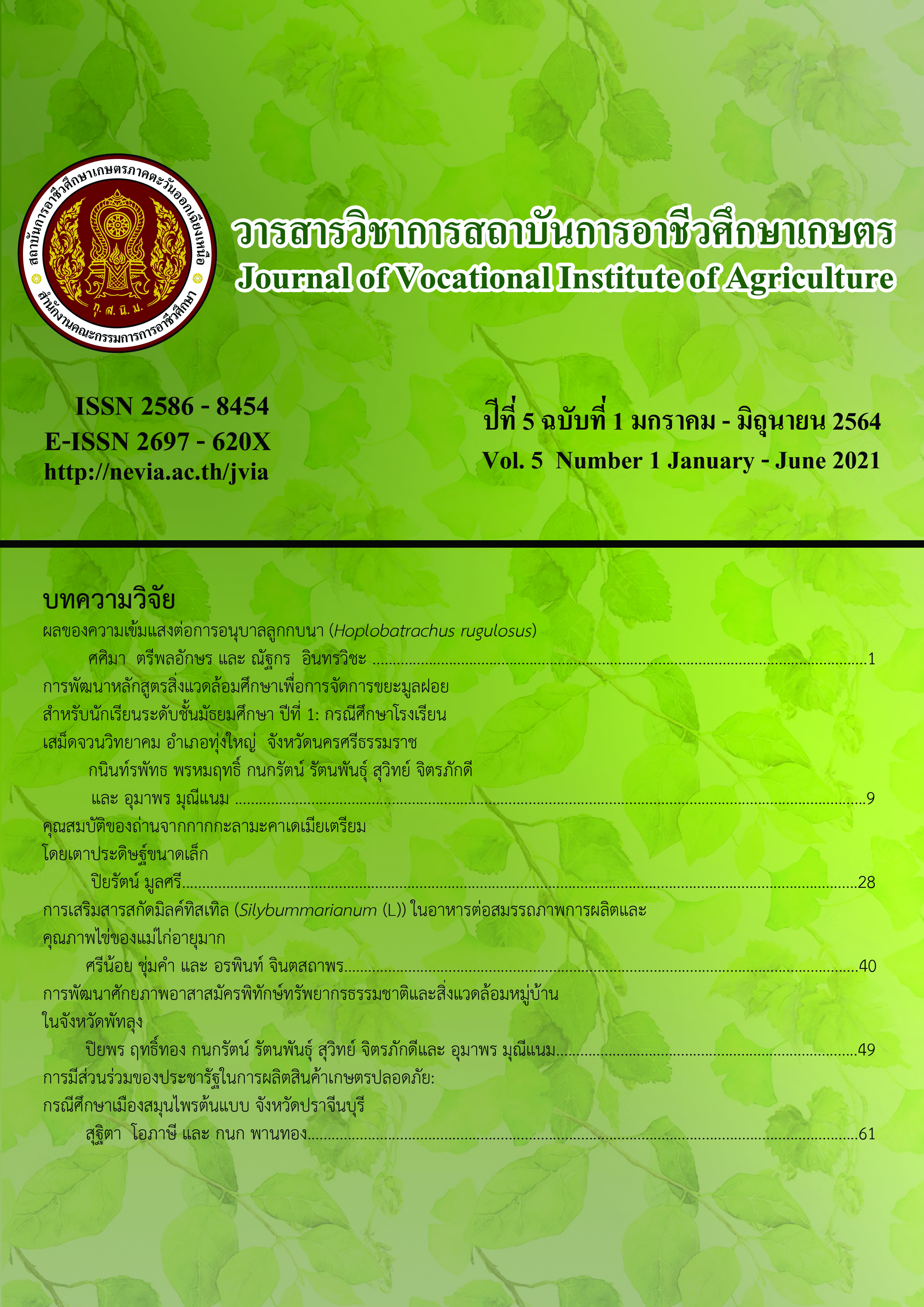Properties of Macadamia Shell Charcoal Prepared by a Small Artificial Furnace
Main Article Content
Abstract
The objective of this research was to study the properties of macadamia shell charcoal prepared in a small artificial furnace. The macadamia shell was agricultural sector waste. The constituents of macadamia shell were cellulose, hemicellulose, lignin and ash in the proportions of 28.9%, 30.5%, 40.3%, and 0.3% by weight, respectively. After the carbonization of 3 kilograms of macadamia shell using a 54 liter-artificial furnace with the highest sintering temperature in the range of 400-500 °C for less than 3 hours, a good quality macadamia charcoal with a shiny surface was obtained with a moderated yield of 40.7%. The macadamia charcoal hadanelectrical conductivity ability. It had a bulk density of 0.46 g cm-3, and had an iodine absorption coefficient value of 374.7 mg g-1. The approximate analysis showed that the quantities of fixed carbon, ash, moisture, and volatile matters were in the proportionsof 83.2%, 6.3%, 4.3%, and 6.2% by weight, respectively. In addition, the high heating value (HHV) of the macadamia shell charcoal when analyzed by a bomb calorimeter was 17.68 MJ kg-1 (or 4,223 kcal kg-1).
Article Details

This work is licensed under a Creative Commons Attribution-NonCommercial-NoDerivatives 4.0 International License.
The content and information in articles published in the Journal of Vocational Education in Agriculture are the opinions and responsibility of the article's author. The journal editors do not need to agree or share any responsibility.
Articles, information, content, etc. that are published in the Journal of Vocational Education in Agriculture are copyrighted by the Journal of Vocational Education in Agriculture. If any person or organization wishes to publish all or any part of it or to do anything. Only prior written permission from the Journal of Vocational Education in Agriculture is required.
References
Mereles, L. G., et al. (2017). Chemical composition of Macadamia integrifolia (Maiden and Betche) nuts from Paraguay. International Food Research Journal, 24(6), 2599-2608.
Wechsler, A., et al. (2013). Macadamia (Macadamia integrifolia) shell and castor (Ricinos communis) oil based sustainable particleboard: A comparison of its properties with conventional wood based particleboard. Materials and Design, 50, 117-123.
Wang, C-H., et al. (1995). Deformation and fracture of Macadamia nuts Part1: Deformation analysis of nut-in-shell. International Journal of Fracture, 69, 14.
Nhuchhen, D. R. & Abdul Salam, P. (2012). Estimation of higher heating value of biomass from proximate analysis: A new approach. Fuel, 99, 55-63.
Schuler, P., et al. (2014). Structure-function relationships in Macadamia integrifolia seed coats-fundamentals of the Hierarchical microstructure. PLOS ONE, 9(8), 1-14.
Moonsri, P. & Hutem, A. (2018). Biomass-briquettes fuel from local wisdom for producer gas production. Kasem Bundit Engineering Journal, 8 (special issue), 286-295.
Teeta, S., et al. (2017). Thermal properties of green fuel briquettes from residue corncobs materials mixed macadamia shell charcoal powder. Journal of Physics: Conference Series, 901, 012042.
Fan, F., et al. (2018). Preparation and properties of hydrochars from macadamia nut shell via hydrothermal carbonization. Royal society open science, 5, 1-10.
Dejang, N., et al. (2015). A preparation of activated carbon from macadamia shell by microwave irradiation activation. Energy Procedia, 79, 727-732.
Ahmadpour, A. & Do, D. D. (1997). The preparation of activated carbon from macadamia nut shell by chemical activation. Carbon, 35(12), 1723-1732.
Technical Association of the Pulp and Paper Industry. (1999). Alpha, beta and gamma cellolose in pulp. Tappi Rule T203 om-88. Atlanta: TAPPI
Browing, B. L. (1963). Handbook of Wood Chemistry and Wood Composite. New York: Interscience Publishers.
Technical Association of the Pulp and Paper Industry. (2002). Test method T 222 om-02 acid-insoluble lignin in wood and pulp. Atlanta: TAPPI
Technical Association of the Pulp and Paper Industry. (2002). Test method T211 om-02 ash in wood, pulp, paper and paperboard. Atlanta: TAPPI
Moonsri, P., et al. (2016). Production of activated carbon from moldy damaged tamarind pod. Applied Mechanics and Materials, 885, 137-142.
Han, J. S. & Rowel, J. S. (1996). Chemical composition of fibers. Boca Raton (FL): CRC Press.

